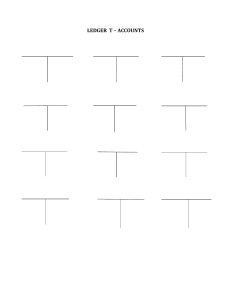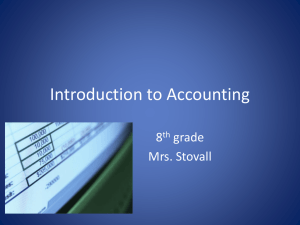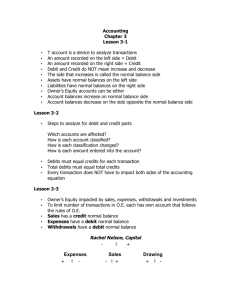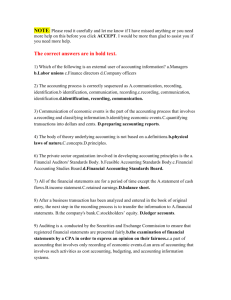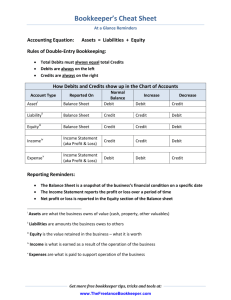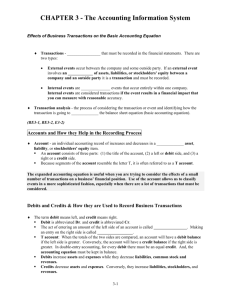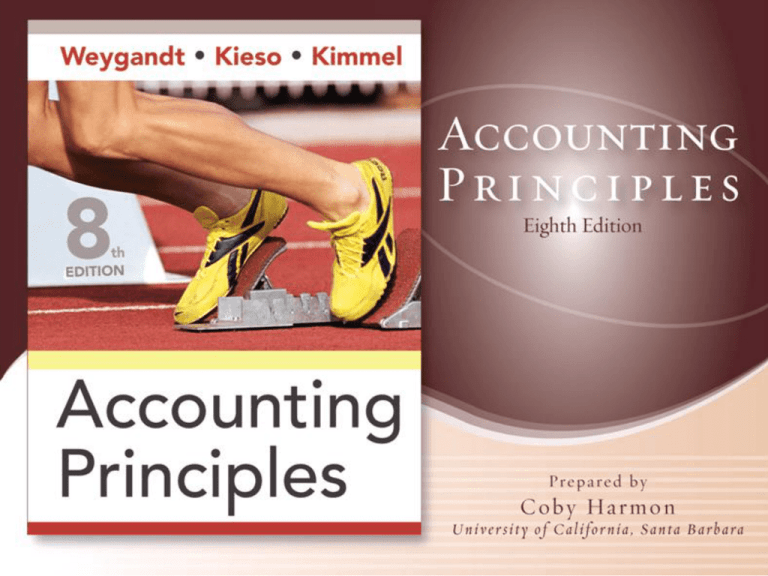
Chapter
2-1
CHAPTER 2
THE RECORDING
PROCESS
Accounting Principles, Eighth Edition
Chapter
2-2
Study Objectives
1.
Explain what an account is and how it helps in the
recording process.
2. Define debits and credits and explain their use in
recording business transactions.
3. Identify the basic steps in the recording process.
4. Explain what a journal is and how it helps in the
recording process.
5. Explain what a ledger is and how it helps in the
recording process.
6. Explain what posting is and how it helps in the
recording process.
7. Prepare a trial balance and explain its purposes.
Chapter
2-3
The Recording Process
The Account
Steps in the
Recording
Process
Debits and
credits
Journal
Ledger
Expansion of
basic equation
Chapter
2-4
The Recording
Process
Illustrated
Summary
illustration of
journalizing
and posting
The Trial
Balance
Limitations of a
trial balance
Locating errors
Use of dollar
signs
The Account
Account
Record of increases and decreases
in a specific asset, liability, equity,
revenue, or expense item.
Debit = “Left”
Credit = “Right”
An Account can
be illustrated in a
T-Account form.
Chapter
2-5
Account Name
Debit / Dr.
Credit / Cr.
LO 1 Explain what an account is and how it helps in the recording process.
Debits and Credits
Double-entry accounting system
Each transaction must affect two or more
accounts to keep the basic accounting equation
in balance.
Recording done by debiting at least one account
and crediting another.
DEBITS must equal CREDITS.
Chapter
2-6
LO 2 Define debits and credits and explain their
use in recording business transactions.
Debits and Credits
If Debits are greater than Credits, the account
will have a debit balance.
Account Name
Debit / Dr.
Transaction #1
$10,000
Transaction #3
8,000
Balance
Chapter
2-7
Credit / Cr.
$3,000
Transaction #2
$15,000
LO 2 Define debits and credits and explain their
use in recording business transactions.
Debits and Credits
If Credits are greater than Debits, the account
will have a credit balance.
Account Name
Debit / Dr.
Transaction #1
Balance
Chapter
2-8
$10,000
Credit / Cr.
$3,000
Transaction #2
8,000
Transaction #3
$1,000
LO 2 Define debits and credits and explain their
use in recording business transactions.
Debits and Credits Summary
Liabilities
Normal
Balance
Debit
Normal
Balance
Credit
Assets
Credit / Cr.
Normal Balance
Chapter
3-24
Owner’s Equity
Credit / Cr.
Debit / Dr.
Debit / Dr.
Debit / Dr.
Credit / Cr.
Normal Balance
Normal Balance
Chapter
3-23
Expense
Debit / Dr.
Revenue
Chapter
3-25
Credit / Cr.
Debit / Dr.
Normal Balance
Chapter
3-27
Chapter
2-9
Credit / Cr.
Normal Balance
Chapter
3-26
LO 2
Debits and Credits Summary
Balance Sheet
Asset = Liability + Equity
Income Statement
Revenue - Expense
Debit
Credit
Chapter
2-10
LO 2 Define debits and credits and explain their
use in recording business transactions.
Debits and Credits Summary
Review Question
Debits:
a. increase both assets and liabilities.
b. decrease both assets and liabilities.
c. increase assets and decrease liabilities.
d. decrease assets and increase liabilities.
Chapter
2-11
LO 2 Define debits and credits and explain their
use in recording business transactions.
Debits and Credits Summary
Discussion Question
Q4. Maria Alvarez, a beginning accounting
student, believes debit balances are favorable
and credit balances are unfavorable. Is Maria
correct? Discuss.
See notes page for discussion
Chapter
2-12
LO 2 Define debits and credits and explain their
use in recording business transactions.
Assets and Liabilities
Assets
Debit / Dr.
Credit / Cr.
Normal Balance
Liabilities – Credits
should exceed debits.
Chapter
3-23
Liabilities
Debit / Dr.
Assets - Debits should
exceed credits.
Credit / Cr.
The normal balance is on
the increase side.
Normal Balance
Chapter
3-24
Chapter
2-13
LO 2 Define debits and credits and explain their
use in recording business transactions.
Owners’ Equity
Owner’s investments and
revenues increase owner’s
equity (credit).
Owner’s Equity
Debit / Dr.
Credit / Cr.
Owner’s drawings and expenses
decrease owner’s equity (debit).
Normal Balance
Chapter
3-25
Owner’s Capital
Debit / Dr.
Chapter
3-25
Chapter
2-14
Owner’s Drawing
Credit / Cr.
Debit / Dr.
Normal Balance
Normal Balance
Credit / Cr.
Chapter
3-23
LO 2 Define debits and credits and explain their
use in recording business transactions.
Revenue and Expense
Revenue
Debit / Dr.
Credit / Cr.
Normal Balance
Chapter
3-26
Expense
Debit / Dr.
Normal Balance
Chapter
3-27
Chapter
2-15
Credit / Cr.
The purpose of earning
revenues is to benefit the
owner(s).
The effect of debits and
credits on revenue accounts
is the same as their effect
on Owner’s Capital.
Expenses have the opposite
effect: expenses decrease
owner’s equity.
LO 2 Define debits and credits and explain their
use in recording business transactions.
Debits and Credits Summary
Review Question
Accounts that normally have debit balances are:
a. assets, expenses, and revenues.
b. assets, expenses, and owner’s capital.
c. assets, liabilities, and owner’s drawings.
d. assets, owner’s drawings, and expenses.
Chapter
2-16
LO 2 Define debits and credits and explain their
use in recording business transactions.
Expansion of the Basic Equation
Relationship among the assets, liabilities and
owner’s equity of a business:
Basic
Equation
Assets = Liabilities +
Owner’s Equity
Illustration 2-11
Expanded
Basic
Equation
The equation must be in balance after every
transaction. For every Debit there must be a Credit.
Chapter
2-17
LO 2 Define debits and credits and explain their
use in recording business transactions.
Steps in the Recording Process
Illustration 2-12
Analyze each transaction
Enter transaction in a journal
Transfer journal information
to ledger accounts
Business documents, such as a sales slip, a check, a
bill, or a cash register tape, provide evidence of the
transaction.
Chapter
2-18
LO 3 Identify the basic steps in the recording process.
The Journal
Book of original entry (General Ledger).
Transactions recorded in chronological order.
Contributions to the recording process:
1. Discloses the complete effects of a transaction.
2. Provides a chronological record of transactions.
3. Helps to prevent or locate errors because the
debit and credit amounts can be easily compared.
Chapter
2-19
LO 3 Identify the basic steps in the recording process.
Journalizing
Journalizing - Entering transaction data in the journal.
E2-4 (Facts) Presented below is information related to
Hanshew Real Estate Agency.
Oct. 1 Pete Hanshew begins business as a real estate agent with
a cash investment of $15,000.
3 Purchases office furniture for $1,900, on account.
6 Sells a house and lot for B. Kidman; bills B. Kidman $3,200
for realty services provided.
27 Pays $700 on balance related to transaction of Oct. 3.
30 Pays the administrative assistant $2,500 salary for Oct.
E2-5 Instructions - Journalize the transactions for E2-4.
Chapter
2-20
LO 4 Explain what a journal is and how it helps in the recording process.
Journalizing
E2-4 (Facts) Presented below is information related
to Hanshew Real Estate Agency.
Pete Hanshew begins business as a real estate
agent with a cash investment of $15,000.
Oct. 1
General Journal
Date
Oct.
Account Title
1
Cash
Hanshew, Capital
Ref.
Debit
Credit
15,000
15,000
(Owners investment)
Chapter
2-21
LO 4 Explain what a journal is and how it helps in the recording process.
Journalizing
E2-4 (Facts) Presented below is information related
to Hanshew Real Estate Agency.
Oct. 3
Purchases office furniture for $1,900, on
account.
General Journal
Date
Oct. 3
Account Title
Office Furniture
Accounts Payable
Ref.
Debit
Credit
1,900
1,900
(Purchase furniture)
Chapter
2-22
LO 4 Explain what a journal is and how it helps in the recording process.
Journalizing
E2-4 (Facts) Presented below is information related
to Hanshew Real Estate Agency.
Oct. 6
Sells a house and lot for B. Kidman; bills B.
Kidman $3,200 for realty services provided.
General Journal
Date
Account Title
Oct. 6
Accounts Receivable
Ref.
Service Revenue
Debit
Credit
3,200
3,200
(Realty services provided)
Chapter
2-23
LO 4 Explain what a journal is and how it helps in the recording process.
Journalizing
E2-4 (Facts) Presented below is information related
to Hanshew Real Estate Agency.
Oct. 27 Pays $700 on balance related to transaction of
Oct. 3.
General Journal
Date
Account Title
Oct. 27
Accounts Payable
Cash
Ref.
Debit
Credit
700
700
(Payment on account)
Chapter
2-24
LO 4 Explain what a journal is and how it helps in the recording process.
Journalizing
E2-4 (Facts) Presented below is information related
to Hanshew Real Estate Agency.
Oct. 30 Pays the administrative assistant $2,500
salary for Oct.
General Journal
Date
Oct. 30
Account Title
Ref.
Salary Expense
Cash
Debit
Credit
2,500
2,500
(Payment for salaries)
Chapter
2-25
LO 4 Explain what a journal is and how it helps in the recording process.
Journalizing
Simple Entry – Two accounts, one debit and one credit.
Compound Entry – Three or more accounts.
Example – On June 15, H. Burns, purchased equipment
for $15,000 by paying cash of $10,000 and the balance
on account (to be paid within 30 days).
General Journal
Date
June 15
Account Title
Equipment
Cash
Accounts Payable
Ref.
Debit
Credit
15,000
10,000
5,000
(Purchased equipment)
Chapter
2-26
LO 4 Explain what a journal is and how it helps in the recording process.
The Ledger
A General Ledger contains the entire group of
accounts maintained by a company.
The General Ledger includes all the asset,
liability, owner’s equity, revenue and expense
accounts.
Chapter
2-27
LO 5 Explain what a ledger is and how it helps in the recording process.
Chart of Accounts
Accounts and account numbers arranged in sequence in
which they are presented in the financial statements.
Hanshew Real Estate Agency
Chart of Accounts
Assets
101
112
126
130
150
158
Cash
Accounts receivable
Advertising supplies
Prepaid insurance
Office equipment
Accumulated depreciation
Owner's Equity
300
306
350
Revenues
400
Liabilities
200
201
209
212
230
Chapter
2-28
Accounts payable
Notes payable
Unearned revenue
Salaries payable
Interest payable
Hanshew, Capital
Hanshew, Drawing
Income summary
Service revenue
Expenses
631
711
722
726
729
905
Advertising supplies expense
Depreciation expense
Insurance expense
Salaries expense
Rent expense
Interest expense
LO 6 Explain what posting is and how it helps in the recording process.
Standard Form of Account
T-account form used in accounting textbooks.
In practice, the account forms used in ledgers are
much more structured.
Cash
Date
Oct.
Chapter
2-29
Explanation
1
27
30
Ref.
No. 101
Debit
Credit
15,000
700
2,500
Balance
15,000
14,300
11,800
LO 5 Explain what a ledger is and how it helps in the recording process.
Posting
Posting – the process of transferring amounts from the
journal to the ledger accounts.
General Journal
Date
Oct. 1
Account Title
Cash
J1
Ref.
Debit
101
15,000
Hanshew, Capital
Credit
15,000
(Owner's investment in business)
General Ledger
Cash
Date
Oct. 1
Chapter
2-30
Explanation
Ref.
J1
Debit
15,000
Acct. No. 101
Credit
Balance
15,000
LO 6 Explain what posting is and how it helps in the recording process.
Posting
Review Question
Posting:
a. normally occurs before journalizing.
b. transfers ledger transaction data to the
journal.
c. is an optional step in the recording process.
d. transfers journal entries to ledger accounts.
Chapter
2-31
LO 6 Explain what posting is and how it helps in the recording process.
The Recording Process Illustrated
Follow these steps:
Illustration 2-19
1. Determine what
type of account
is involved.
2. Determine what
items increased
or decreased
and by how
much.
3. Translate the
increases and
decreases into
debits and
credits.
Chapter
2-32
LO 6 Explain what posting is and how it helps in the recording process.
The Trial Balance
A list of accounts
and their balances
at a given time.
Purpose is to
prove that debits
equal credits.
Chapter
2-33
Hanshew Real Estate Agency
Trial Balance
October 31, 2008
Cash
Accounts receivable
Office furniture
Accounts payable
Hanshew, Capital
Service revenue
Salaries expense
Debit
$ 11,800
3,200
1,900
Credit
$
2,500
$ 19,400
1,200
15,000
3,200
$ 19,400
LO 7 Prepare a trial balance and explain its purposes.
The Trial Balance
Limitations of a Trial Balance
The trial balance may balance even when
1. a transaction is not journalized,
2. a correct journal entry is not posted,
3. a journal entry is posted twice,
4. incorrect accounts are used in journalizing or
posting, or
5. offsetting errors are made in recording the
amount of a transaction.
Chapter
2-34
LO 7 Prepare a trial balance and explain its purposes.
The Trial Balance
Review Question
A trial balance will not balance if:
a. a correct journal entry is posted twice.
b. the purchase of supplies on account is debited to
Supplies and credited to Cash.
c. a $100 cash drawing by the owner is debited to
Owner’s Drawing for $1,000 and credited to
Cash for $100.
d. a $450 payment on account is debited to
Accounts Payable for $45 and credited to Cash
for $45.
Chapter
2-35
LO 7 Prepare a trial balance and explain its purposes.
Recording Process
Discussion Question
Q2-19. Jim Benes is confused about how accounting
information flows through the accounting system. He
believes the flow of information is as follows.
a. Debits and credits posted to the ledger.
b. Business transaction occurs.
c. Information entered in the journal.
d. Financial statements are prepared.
e. Trial balance is prepared.
Is Jim correct? If not, indicate to Jim the proper flow
of the information.
See notes page for discussion
Chapter
2-36
LO 7 Prepare a trial balance and explain its purposes.
Copyright
Copyright © 2008 John Wiley & Sons, Inc. All rights reserved.
Reproduction or translation of this work beyond that permitted
in Section 117 of the 1976 United States Copyright Act without
the express written permission of the copyright owner is
unlawful. Request for further information should be addressed
to the Permissions Department, John Wiley & Sons, Inc. The
purchaser may make back-up copies for his/her own use only
and not for distribution or resale. The Publisher assumes no
responsibility for errors, omissions, or damages, caused by the
use of these programs or from the use of the information
contained herein.
Chapter
2-37


